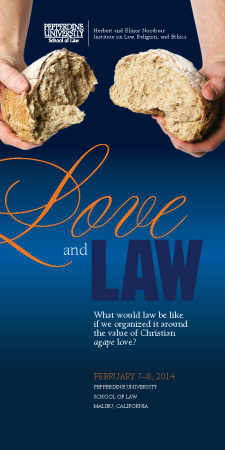Love and Law
 February 7-8, 2014
February 7-8, 2014
Keynote presentations
Brochure
In a provocative essay, philosopher Jeffrie Murphy asks: "What would law be like if we organized it around the value of Christian love [agape]?" Agape love is love that is focused on the good of the other and is distinguished from other forms of love—from friendship, romance, and sexual love. Murphy notes that agape love is not simply concerned with making people's lives more pleasant--it is not "cuddly." If agape is the aim, a polity might "design legal practices and institutions with a view to the moral and spiritual improvement of affected citizens." Other theological and moral traditions also wrestle with the relationship between law and religious concepts of love, including Judaism's hesed and ahava, Islam's rahman, and Hinduism's karma.
The notion of law grounded in love has a rich history. Jesus summarized the Mosaic Law as love of God and neighbor. John Calvin said that all nations' laws "must be in conformity to that perpetual rule of love." Over the centuries groups have sought to ground law in love, to good and ill effect. The idea that law should be a manifestation of love stands in tension with modern and post-modern notions that law should be solely concerned with individual autonomy or efficiency or that law is by nature only a matter of power.
Law might bear several sorts of relationships to love. Love might be the motivation behind the work of lawyers, judges, legislators, police, and politically active citizens. The adoption and enforcement of wise laws can be among the most loving things that someone can do. It may also be that law can teach and encourage love.
The idea of law grounded in love generates numerous big questions which we addressed
in this year's conference.
_______________________
1. Jeffrie G. Murphy, "Christian love and criminal punishment," in Christianity and the Law: and Introduction, eds. John Witte and Frank S. Alexander (Cambridge University Press, 2008), 219.